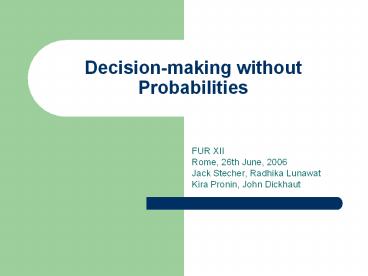Decision-making without Probabilities - PowerPoint PPT Presentation
1 / 11
Title:
Decision-making without Probabilities
Description:
How do agents make choices when they only have information in the form of ranges? ... Interval-based Pref. - Buyer. Inexplicable. Lowest possible ex ante value ... – PowerPoint PPT presentation
Number of Views:12
Avg rating:3.0/5.0
Title: Decision-making without Probabilities
1
Decision-making without Probabilities
- FUR XII
- Rome, 26th June, 2006
- Jack Stecher, Radhika Lunawat
- Kira Pronin, John Dickhaut
2
Issue
- How do agents make choices when they only have
information in the form of ranges? - Motivation historically, individuals have kept
track of and compared ranges of outcomes, even
before probability was part of anyones
vocabulary - We test two models of individual choice behavior
where information is in the form of ranges
3
Experiment
- 1 seller, 4 potential buyers, bid for a
financial asset where possible return given in
form of a range
1 2 3 4 5
Seller has 1000 fr to invest Possible return (-0.1, 0.5) Seller invests S0 New information to seller Possible return (?, ?)?(-0.1, 0.5) Seller decides reservation price based on information received in step 2 Buyers learn ?and S0 Possible return (?, 0.5) Buyers privately decide what to bid in a first-price sealed bid auction. Buyers can bid up to 1500 fr.
Note 4 fr 1 Canadian cent
4
Claims
- 3 types of behavior
- Consistent with expected utility maximization
- Consistent with interval-based preference theory
- Inexplicable
- Results most often consistent with
interval-based preference theory
5
Expected Utility Theory
- Simplest case Risk-neutrality (can be
generalized) - Seller decides on initial investment all or
nothing, depending on sign of E(?) - Seller sets reservation price to expected value
- Buyer learns ?? (?, 0.5)
- Buyer foresees that any winning bid will have
negative expected value ? Bids in 0, (1?) S0 - 4. Market prediction NO TRADE
6
Interval-based preference theory
- General idea Choices and market prices are based
on intervals - Sellers can invest anything in the interval
between 0 and 1000 - Reservation price is in the interval between
(1?) S0 and (1?) S0, with ? lt 0.5 - Bids are in the interval between (1 ?)S0 and
(1.5)S0 - Trade can occur in this range.
7
Bid Intervals
Expected utility - Buyer
Interval-based Pref. - Buyer
Inexplicable
0.9S0
(1?)S0
0
1.5S0
1500
(1?)S0
Lowest possible ex ante value
Ex post lower bound for buyer/seller
Highest possible ex ante value
Highest possible bid
Ex post upper bound for seller
Sellers reservation price
8
Remarks about the Experiment
- The experiments were run in Canada at CIRANO
Research Institute, with 20 subjects in 4 groups
of 5, who played this game for 20 rounds per
group. Subjects earned from C20.75 C30, plus
C10 show-up. - The sellers average investment was typically NOT
all or nothing - Sellers investment was 0 only once (1.4)
- Sellers invested their full endowment, 1000 fr,
14 times (19.7) - This was consistent with Interval-based
Preference Theory but not with risk-neutral
Expected Utility maximization.
9
Results Buyers Bids
10
Results Market Prices
11
Summary
- When given information in the form of ranges,
individuals tend to behave consistently with
interval-based preference theory rather than how
expected utility theory predicts - However, a core group behaved consistently with
expected utility maximization





























